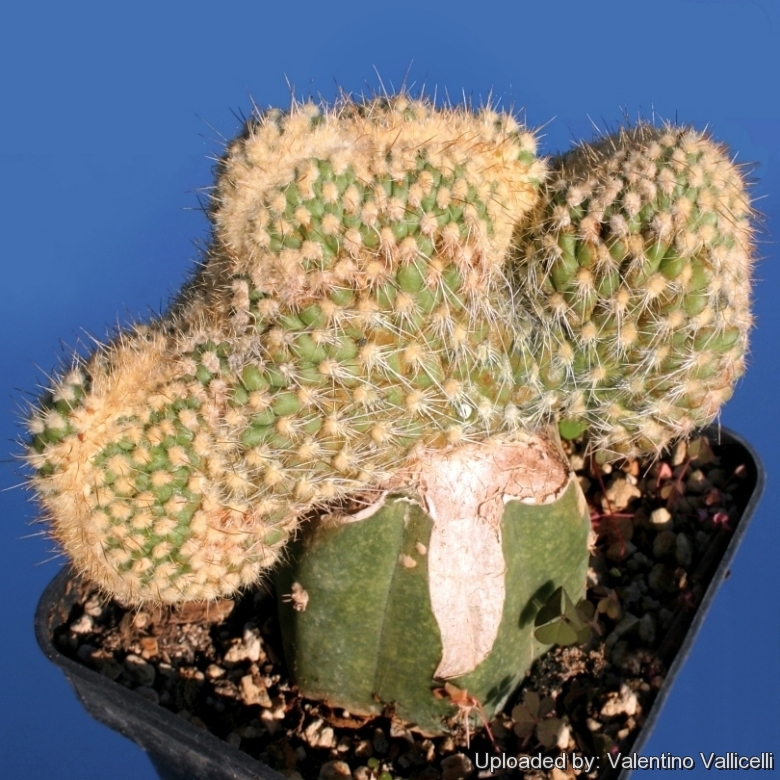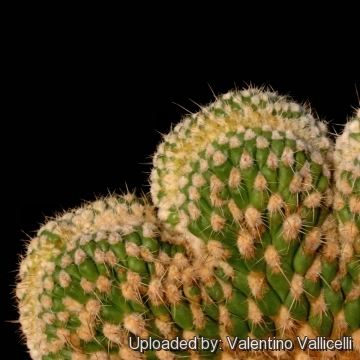Accepted Scientific Name: Austrocylindropuntia pachypus (K.Schum.) Backeb.
Cactaceae (Berlin) Jahrb. Deutsch. Kakt.-Ges. 1941, Pt. 2, 13 (1942); cf. Gray Herb.Card Cat.

Austrocylindropuntia pachypus f. cristata Photo by: Valentino Vallicelli
Origin and Habitat: Peru (north of Lima - Chosica Valley) at low elevations of (600 to 1500 m)
Synonyms:
See all synonyms of Austrocylindropuntia pachypus
back
Accepted name in llifle Database:Austrocylindropuntia pachypus (K.Schum.) Backeb.Cactaceae (Berlin) Jahrb. Deutsch. Kakt.-Ges. 1941, Pt. 2, 13 (1942); cf. Gray Herb.Card Cat.Synonymy: 5
back
Description: The standard Austrocylindropuntia pachypusSN|4183]]SN|4183]] is a slow growing columnar cactus usually solitary. (Sometimes it will branch from the base). Up to 1 m tall segments up to 8 cm in diameter. The crested form is more common in cultivation than the normal columnar shaped form (which is also quite rare and esteemed by impassioned).
Subspecies, varieties, forms and cultivars of plants belonging to the Austrocylindropuntia pachipus group
Bibliography: Major references and further lectures
1) Ostalaza, C., Cáceres, F. & Roque, J. 2013. Austrocylindropuntia pachypus. The IUCN Red List of Threatened Species 2013: e.T151737A555860. http://dx.doi.org/10.2305/IUCN.UK.2013-1.RLTS.T151737A555860.en. Downloaded on 26 March 2016.
2) Arakaki, M., Ostolaza, C., Cáceres, F. and Roque, J. “Cactaceae endémicas del Perú.” Revista Peruana de Biología 13(2): 193s-291s. 2006
3) N. L. Britton, J. N. Rose: “The Cactaceae. Descriptions and Illustrations of Plants of the Cactus Family.” Vol I, The Carnegie Institution of Washington, Washington 1919
4) Curt Backeberg “Die Cactaceae: Handbuch der Kakteenkunde”, Volume 6 G. Fischer, 1962
5) Hunt, D., Taylor, N. and Charles, G. “The New Cactus Lexicon.” dh Books, Milborne Port, UK. 2006
6) Anderson, E. F. “The cactus family” 2001
7) Clive Innes “Complete Handbook of Cacti and Succulents” Van Nostrand Reinhold Company, 01 December 1981
8) Urs Eggli, Leonard E. Newton “Etymological Dictionary of Succulent Plant Names” Springer Science & Business Media, 29 June 2013
9) Ritter, F. “Kakteen in Südamerika”. Vol. IV. Peru 1239–1692. Friedrich Ritter Selbstverlag, Spangenberg. 1981.
10) Brako, L. & J. L. Zarucchi. “Catalogue of the flowering plants and gymnosperms of Peru.” Monogr. Syst. Bot. Missouri Bot. Gard. 45. [= Opuntia pachypus K. Schum.]. 1993.
11) Austrocylindropuntia pachypus in: “Encyclopédie: Austrocylindropuntia” by Philippe Corman Succulentopi@ N°11 - Octobre 2014 Pages 13-15. retrieved 27 March 2016 from <https://www.cactuspro.com/succulentopia/Succulentopia-N11-2014-10.pdf>
12) Gilmer K., Thomas H.P., Schulz W., “Beobachtungen an Austrocylindropuntia pachypus 13) (Opuntioideae).” Kakteen und andere Sukkulenten 56: 169-177 (2005)
14) Mackie R., "Opuntia pachypus", British Cactus and Succulent Journal, 16(1): 20 (1998), and "Opuntia pachypus, an update", British Cactus and Succulent Journal, 18(1): 43 (2000).
15) Putnam E.W., “Cactus album n°15, Opuntia pachypus”, National Cactus and Succulent Journal 30(1): 18 (1975)
16) PhD Thesis: Cristina Geiger H., “Phytochemical Study of Opuntia Pachypus,” B.S., Catholic University, Lima-Peru.
 Austrocylindropuntia pachypus f. cristata Photo by: Cactus Art
Austrocylindropuntia pachypus f. cristata Photo by: Cactus Art Austrocylindropuntia pachypus f. cristata Photo by: Valentino Vallicelli
Austrocylindropuntia pachypus f. cristata Photo by: Valentino VallicelliCultivation and Propagation: Austrocylindropuntia pachypusSN|4092]]SN|4183]] f. cristata is a slow growing species, quite sensitive to moisture and difficult to propagate. Thereby it is sold grafted.
Watering needs: It needs moderate watering during the growing season; keep dry in winter.
Soil: It requires a drained and mineral potting mix.
Exposure: A. pachypus needs a full sun exposure.
Temperature requirements. They needs a relatively high temperature (at least 5-8 ° C depending on the rootstock).
Propagation: It is best reproduced by grafting, because cutting usually don't manage to produce roots or root very slowly and unpredictably. For this reason this plant is often grafted. Austrocylindropuntia subulataSN|4183]]SN|4092]] is often used as a rootstock, but not particularly recommended because too powerful and too sensitive to cold.












